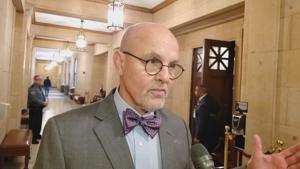(The Center Square) – The Illinois legislature passed and the governor signed a bill to create the Underground Railroad Task Force.
Not enough people know the history of the role Illinois played in the Underground Railroad to assist in relocating slaves to where they could be free, Tazewell County Clerk and genealogist John Ackerman said.
“People say, ‘Wow. I thought that was out east. I thought that was Harriet Tubman. I didn’t realize that that took place here,” Ackerman said.
Thanks to Ackerman’s advocacy and the lead sponsorship of state Sen. David Koehler, D-Peoria, the legislature passed Senate Bill 1623 to convene a 10 member statewide Underground Railroad Task Force to develop ideas about how to make this Illinois history better known. Gov. J.B. Pritzker signed the measure last month.
“Everybody is invited to join with the group to bring ideas forward on how we can properly recognize this Illinois history and promote education and tourism opportunities,” Ackerman said.
People really respond to tales from this little known chapter in state history, Ackerman said. At one Underground Railroad commemoration event in Tazewell County, 200 people showed up.
The Underground Railroad had four significant routes through Illinois. One came up from the Shenandoah Valley to Springfield and Bloomington and on to Chicago. A second route passed through Alta and Jacksonville, then went north through Tazewell County and Woodfield.
The Knox College route went through the tip of Peoria County, hooked sharply north to the Owen Lovejoy mansion in Princeton before heading northward to Wisconsin and Chicago.
A fourth route followed the Rock River across the Mississippi, up into Wisconsin and to freedom that way.
Racism was rampant in 1840s Illinois. Aiding runaway slaves was illegal, quite controversial and dangerous, Ackerman said. The work was highly secret. When Underground Railroad conductors died, people did not acknowledge the role they played in their obituaries and on their tombstones. Many heroic Underground Railroad conductors have been forgotten.
Farmers who were caught helping runaway slaves faced 6 months in jail and fines of $1,000, a hefty sum for a farmer in the 1840s and 1850s, Ackerman said.
There were vicious bounty hunters, treachery, murder and plenty of intrigue along the Illinois Underground Railroad, Ackerman said.
“This task force will give students and residents a view of the rich history that exists throughout our communities,” Koehler told WMBD in June. “Residents and non-residents will gain a new perspective on slavery and its impact toward our nation.”
Members of the commission will serve without compensation but will be supported by the Illinois Department of Natural Resources. Once constituted, a report with findings and recommendations will be made to the General Assembly and the governor by July 1, 2024.







